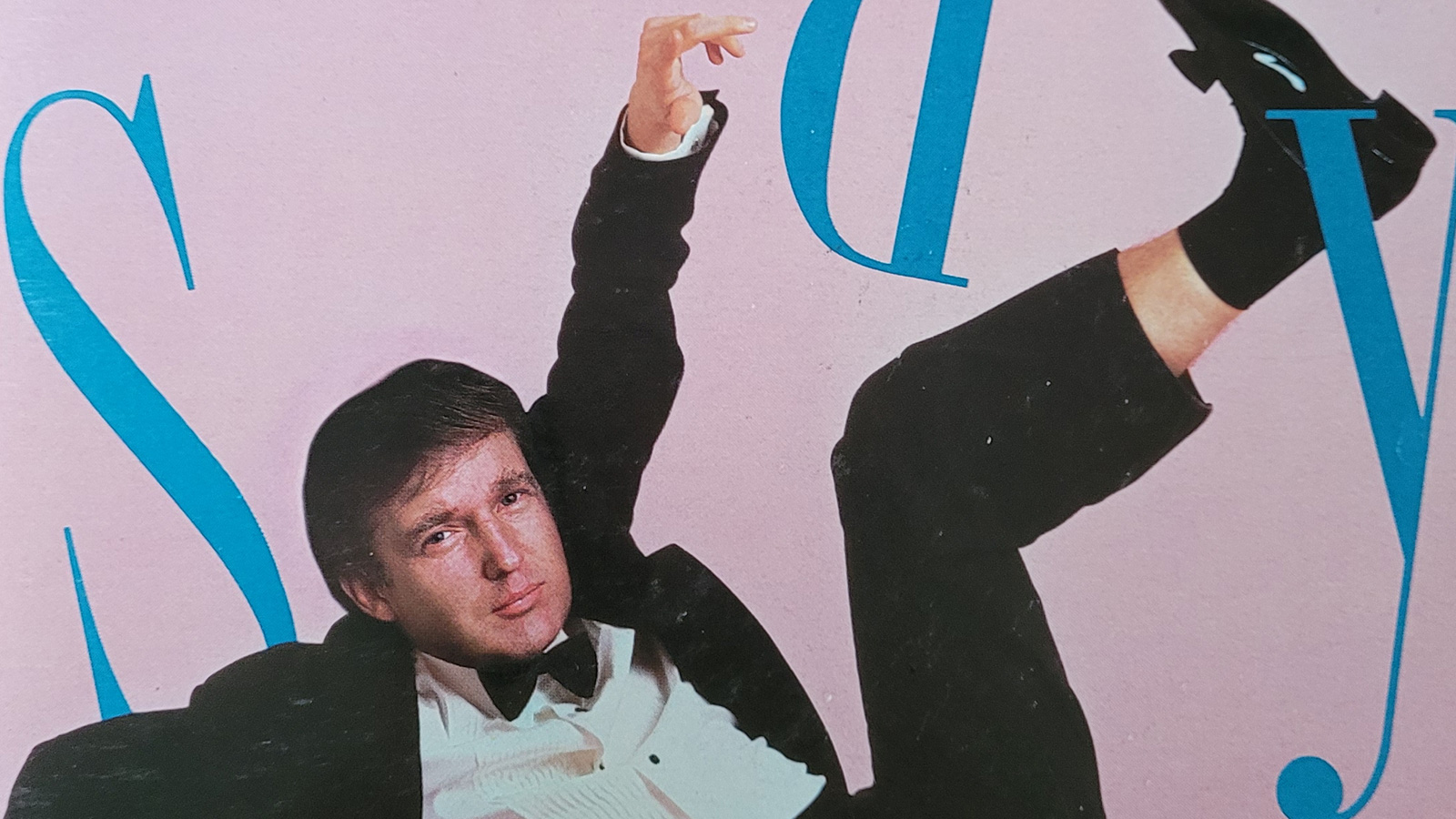SPY (1986-1998) was known from the start for its clever typography and visual gags. In April 1988 (“The Nice Issue,” $2.50), the cover featured Donald Trump, pictured against a friendly, shell-pink background; he’s in evening gear, complete with patent-leather opera pumps, and giving what would one day become an unpleasantly familiar thumbs-up. The punchline came when you opened the cover to reveal the second cover inside—the real one, according to the interior pagination—in which the hapless mogul has crashed to the shell-pink floor, along with the scattered letters of the outer cover’s headlines.
Ho ho! Things are not so nice after all, eh, SPY? Touché!
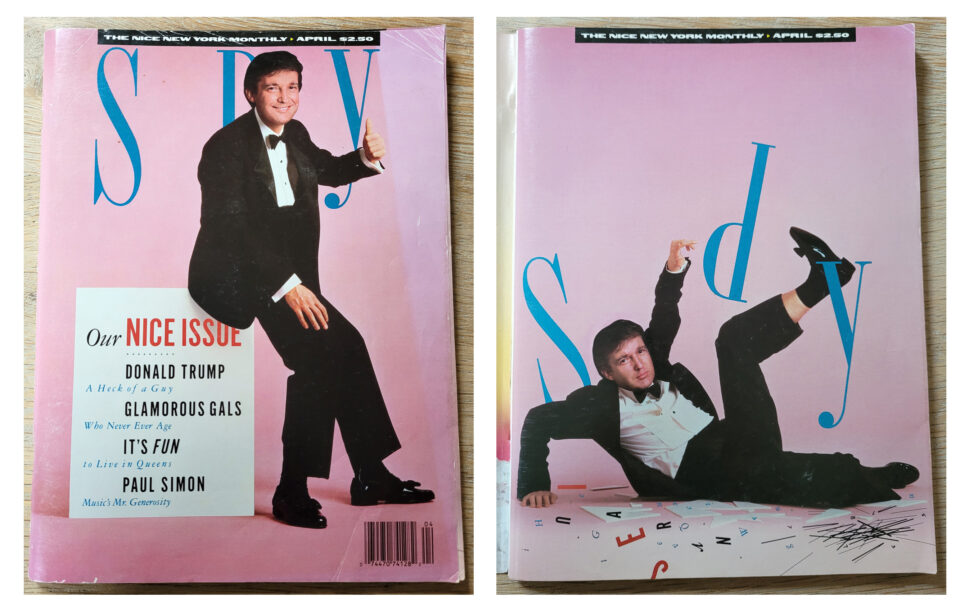
The photos of Trump are ostentatiously faked; the photo credits list “Deborah Feingold (body) and Joe McNally/Wheeler Pictures (head).” The images were composed by hand, too; a few months later, the very first (black-and-white) version of Photoshop was sold to Adobe.
I hadn’t looked at my copy of this magazine for ages, but I chanced across it the other day and was freaked out on multiple levels. The issue currently sells for hundreds of bucks on eBay, I was surprised to learn.
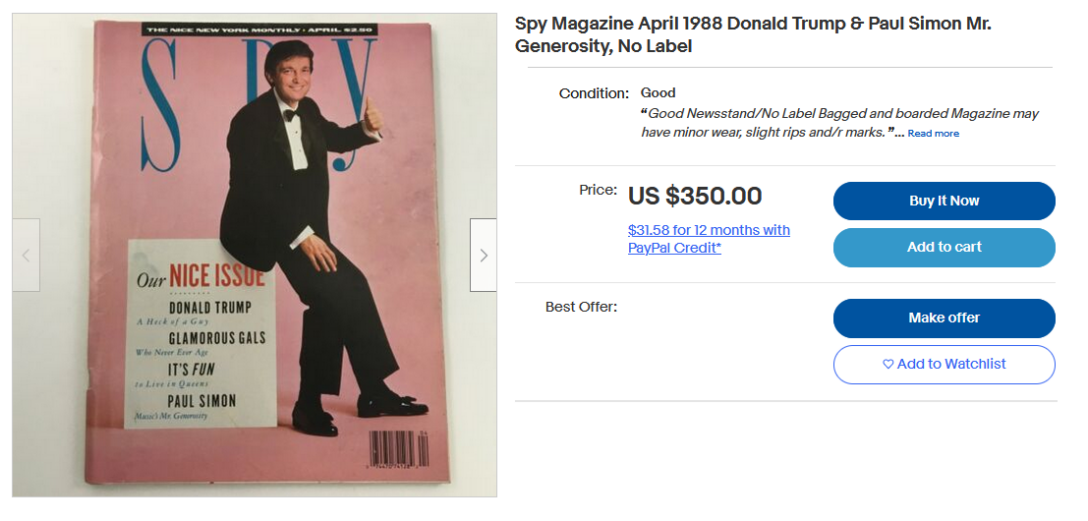
Let me save you the money, on the off chance you wanted to read about Trump; there isn’t much about him in there. There’s an extended pan of The Art of the Deal, conjoined with a pan of Julian Schnabel’s CVJ: Nicknames of Maître D’s & Other Excerpts from Life, with fake ads for both books.
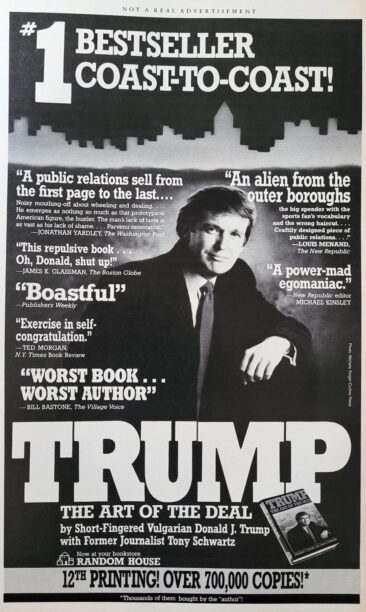
SPY, as has often been remarked, was the Gawker of its day—“irreverent” and “satirical,” poking fun at the rich and powerful, blah blah. I was a dedicated young subscriber back then. But now that we are antiques, nearly 35 years on, it’s clear as day that SPY and I were right in the pockets of the rich and powerful whom we professed to scorn.
All too clearly, ridiculing the “short-fingered vulgarian” Donald Trump turned out to be worse than useless. No way can I express how impossible it is to those who lived through the 1980s, I still can’t quite believe it really happened that this man eventually became the literal president of the United States—a role in which he behaved about a million times worse than anybody, at SPY or anywhere, could have predicted in our most deranged nightmares.
When you look at the ads, it’s easy to see how this worked, and how it still works. Here’s a partial list of ads from the issue in question:
Sharper Image: inside cover, a great big clanking Aiwa “personal stereo,” (we all called these “a Walkman,” regardless of manufacturer)
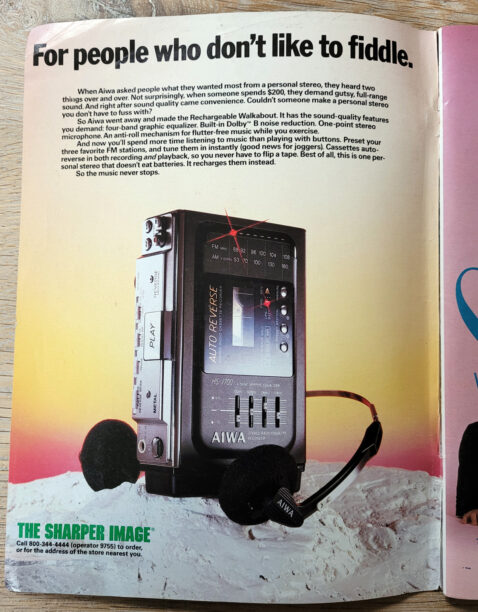
Georges Marciano: inside (second, real) front cover, little boys with surfboards
People Magazine: a collage including period-specific icons, e.g. Anjelica Huston adoringly caressing the chin of her soon-to-be-ex-boyfriend, Jack Nicholson; Phil Collins in shorts and a Gilligan hat, lying down; Dana Carvey as the Church Lady of SNL; Richard Nixon shaking hands with Robocop
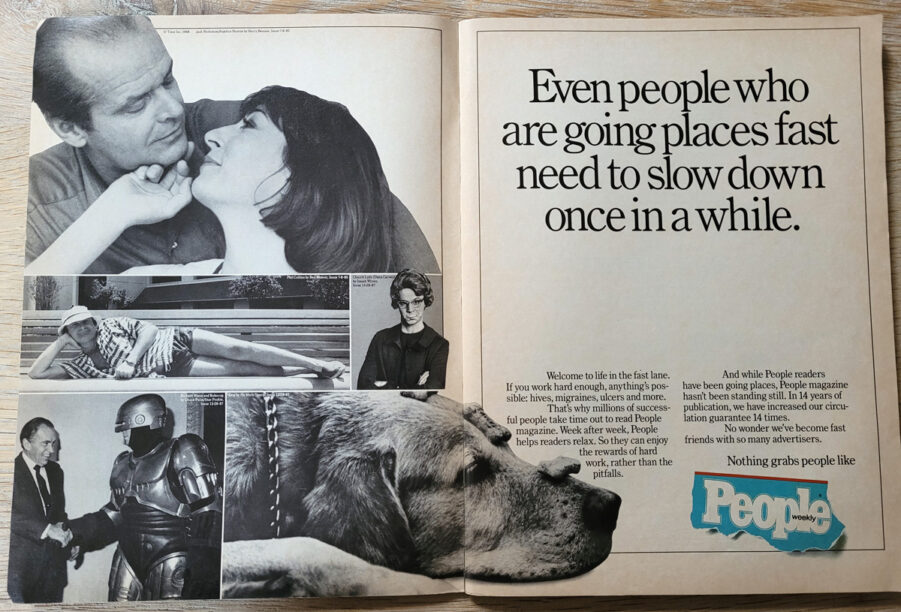
Lancôme: Isabella Rossellini in a Carolyne Roehm blouse (mentions of Carolyne Roehm in WWD could be concatenated into a tragic novel in the style of George Eliot with very little editing)
Matsuda: a bearded, bespectacled fellow, beautifully dressed, pale fedora, braided queue, wearing a big (linen?) jacket, carrying a walking-stick, this guy looks like a Mast brother
Marie Brizard anisette
Tiffany & Co. sterling flask in the shape of a fish
Fiasco: a sensational restaurant, they rubber-stamped the menu onto butcher paper that served as a tablecloth, and the paglia e fieno… I remember it still
Charivari: ravishing woman in a Claude Montana space-minidress and an earnest-looking kid in Armani eveningwear; the greatest shop, it was like a church to me then
Urban Outfitters: six locations listed, in Philadelphia, Cambridge, NYC, and DC
Jimmy’z: skater gear, whatever
Interview: feat. an achingly young Ad-Rock, cigarette between his lips
About a bazillion other restaurants that no longer exist
ok I’m on page 23 now
SPY gave me the sense of belonging in a world I loved, but I didn’t even see how that world had been constructed, how Conquest of Cool it was, how the cheerfully ridiculous brutality of its writers was in the service of the ads. Even I, a broke tchotchke designer, wearing a barrel basically, could sometimes afford to eat a beautiful lunch at Fiasco, and improvise my next party outfit around the glorious vibe of the girl in the Charivari ad. I loved New York, and beautiful things, and fun, and people who could enter into a joke. But this world, I failed to understand, was a world in which Donald Trump was on the cover. The people who made it were court jesters, paid for their impertinence.
The cover of the magazine, insofar as that person is the most worthy of attention, you’re making that person the leader of the world you’ve shown. And this has not changed in the era of Marjorie Taylor Greene, Elon Musk, George Santos and Tucker Carlson.
Journalists still spend our days jeering at the worst people in the world, stewing our brains in the bile they prepare for us each day, using so much collective time and intelligence to achieve, what, nothing at all aside from elevating them to more and more public notice—and still worse than that.
As demonstrated by this shell-pink fake pratfall from the olden time, it will actually help the worst person ever to become president, many years later, when he decides he wants to do that, and why, because we will have familiarized people with that guy, subscribed to the magazine with him on the cover, put him next to ads for Charivari and ABC Carpet and Home and all the other things we like, and buy, or hope to buy someday; made him worthy of clever little jokes and quips in the coolest magazine in New York and what a depressing way to squander one’s few moments of life on Earth, in retrospect.
I’m not saying it wasn’t hilarious at the time, I loved it!
I was like, in my twenties—but if I’d known how it would all turn out?
In closing, two things: (1) the worst people do not go away unless they die, and by and large, they won’t. They have no shame, and so, when they are rejected and showered in humiliations that would drive an ordinary person into a life of absolute obscurity, no, the most extreme deterrent doesn’t even slow them down, in fact it’s like a spur to their greater efforts. No shame means no stress, they welcome the attention that ridicule brings, they grow fat and powerful on it, these people live fucking forever, by which I mean there is a nonzero chance you’ll still be reading about George Santos a quarter century from now; and (2) it is a real mistake to underestimate the wickedness even the most ridiculous person might prove himself capable of, in the fullness of time.

